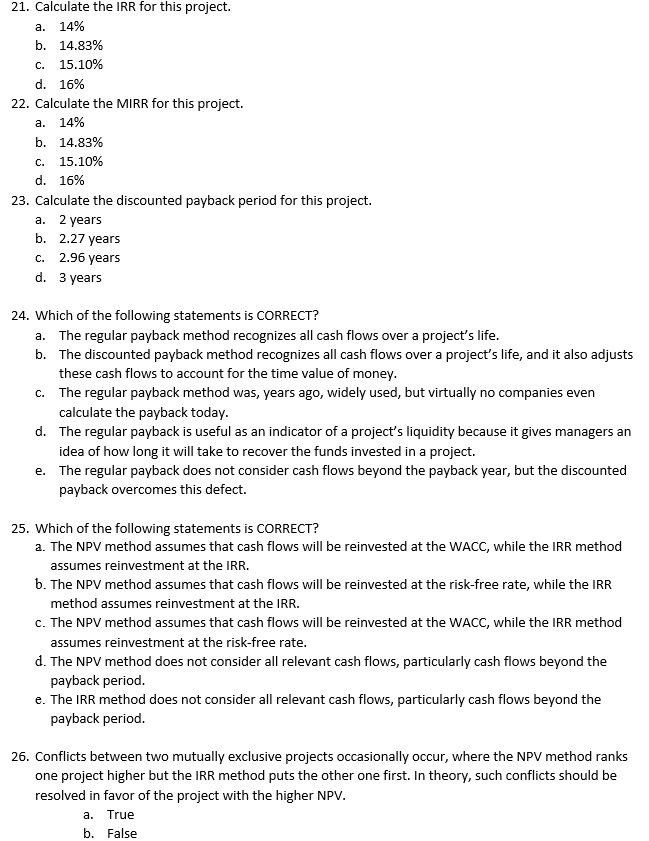
- Calculate the IRR for this project.
C. 21. Calculate the IRR for this project. a. 14% b. 14.83% 15.10% d. 16% 22. Calculate the MIRR for this project. a. 14% b. 14.83% C. 15.10% d. 16% 23. Calculate the discounted payback period for this project. a. 2 years C. b. 2.27 years 2.96 years d. 3 years 24. Which of the following statements is CORRECT? a. The regular payback method recognizes all cash flows over a project's life. b. The discounted payback method recognizes all cash flows over a project's life, and it also adjusts these cash flows to account for the time value of money. C. The regular payback method was, years ago, widely used, but virtually no companies even calculate the payback today. d. The regular payback is useful as an indicator of a project's liquidity because it gives managers an idea of how long it will take to recover the funds invested in a project. e. The regular payback does not consider cash flows beyond the payback year, but the discounted payback overcomes this defect. 25. Which of the following statements is CORRECT? a. The NPV method assumes that cash flows will be reinvested at the WACC, while the IRR method assumes reinvestment at the IRR. b. The NPV method assumes that cash flows will be reinvested at the risk-free rate, while the IRR method assumes reinvestment at the IRR. c. The NPV method assumes that cash flows will be reinvested at the WACC, while the IRR method assumes reinvestment at the risk-free rate. d. The NPV method does not consider all relevant cash flows, particularly cash flows beyond the payback period. e. The IRR method does not consider all relevant cash flows, particularly cash flows beyond the payback period. 26. Conflicts between two mutually exclusive projects occasionally occur, where the NPV method ranks one project higher but the IRR method puts the other one first. In theory, such conflicts should be resolved in favor of the project with the higher NPV. True b. False a. C. 21. Calculate the IRR for this project. a. 14% b. 14.83% 15.10% d. 16% 22. Calculate the MIRR for this project. a. 14% b. 14.83% C. 15.10% d. 16% 23. Calculate the discounted payback period for this project. a. 2 years C. b. 2.27 years 2.96 years d. 3 years 24. Which of the following statements is CORRECT? a. The regular payback method recognizes all cash flows over a project's life. b. The discounted payback method recognizes all cash flows over a project's life, and it also adjusts these cash flows to account for the time value of money. C. The regular payback method was, years ago, widely used, but virtually no companies even calculate the payback today. d. The regular payback is useful as an indicator of a project's liquidity because it gives managers an idea of how long it will take to recover the funds invested in a project. e. The regular payback does not consider cash flows beyond the payback year, but the discounted payback overcomes this defect. 25. Which of the following statements is CORRECT? a. The NPV method assumes that cash flows will be reinvested at the WACC, while the IRR method assumes reinvestment at the IRR. b. The NPV method assumes that cash flows will be reinvested at the risk-free rate, while the IRR method assumes reinvestment at the IRR. c. The NPV method assumes that cash flows will be reinvested at the WACC, while the IRR method assumes reinvestment at the risk-free rate. d. The NPV method does not consider all relevant cash flows, particularly cash flows beyond the payback period. e. The IRR method does not consider all relevant cash flows, particularly cash flows beyond the payback period. 26. Conflicts between two mutually exclusive projects occasionally occur, where the NPV method ranks one project higher but the IRR method puts the other one first. In theory, such conflicts should be resolved in favor of the project with the higher NPV. True b. False a







